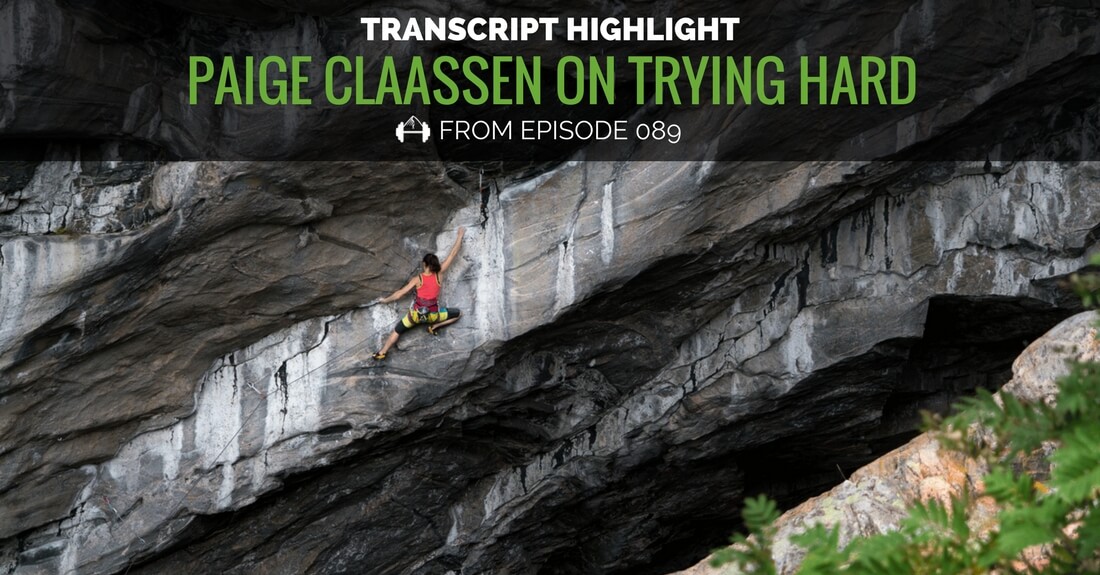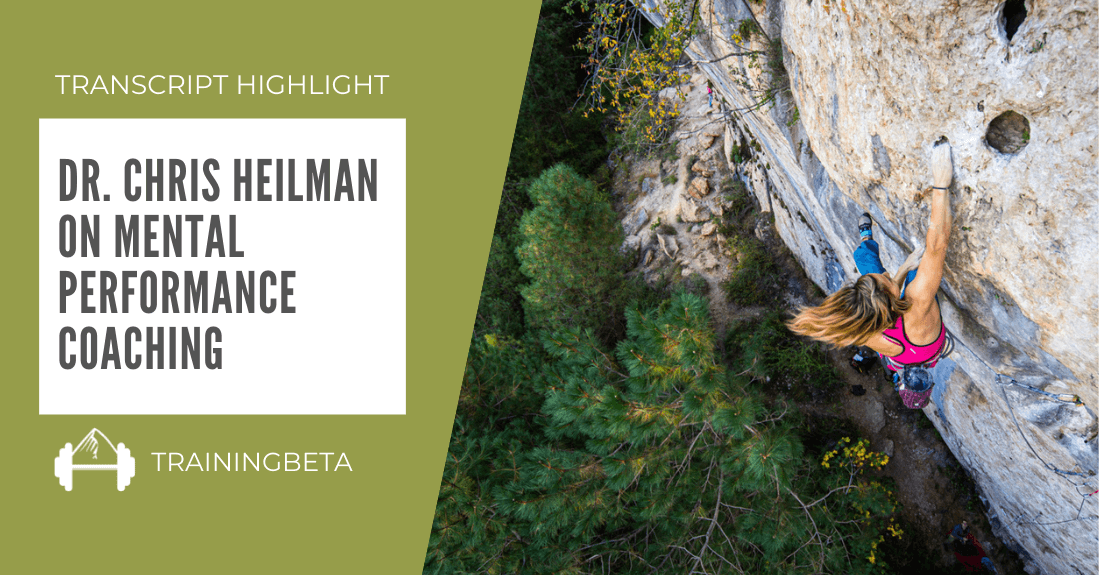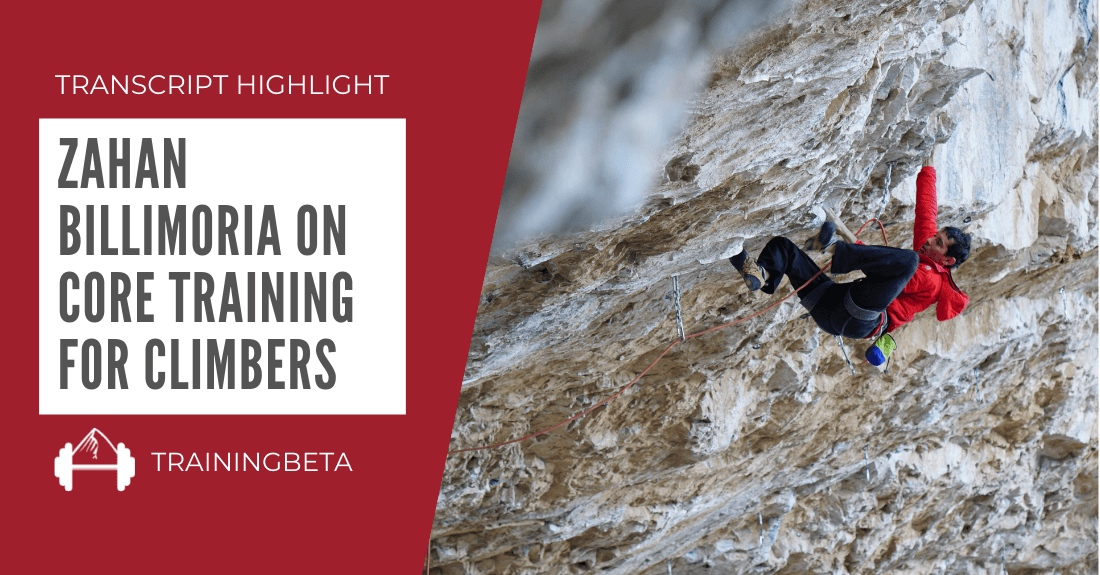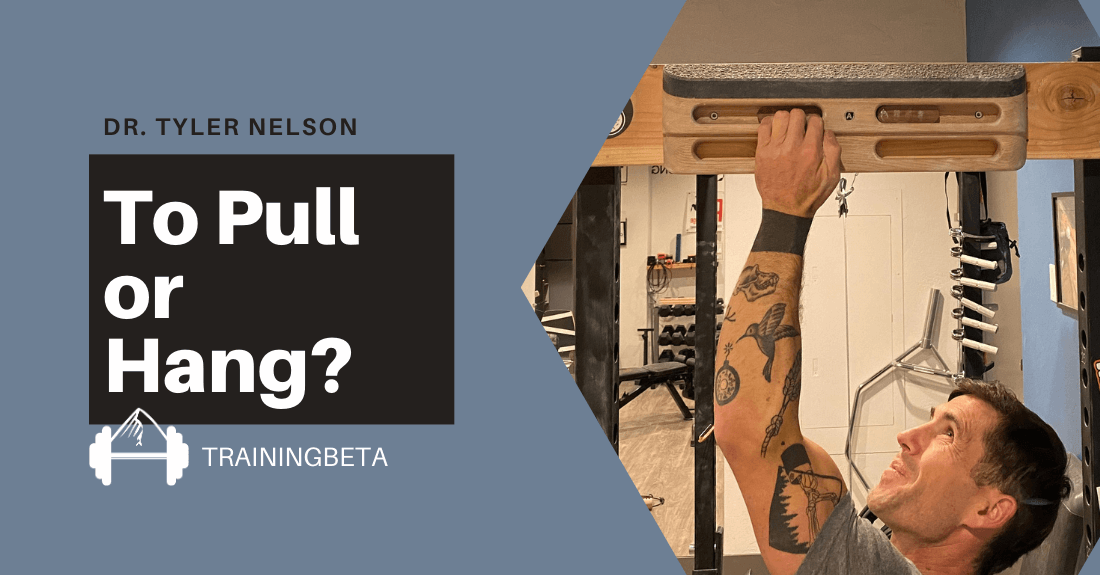Paige Claassen just sent the historic Necessary Evil 5.14c in the VRG. She had tried this route in the past, trained specifically for it, and then stuck it out at the crag to come away with a send. Congrats Paige!
I (Matt Pincus) was there for many of her attempts can attest to the fact that Paige TRIES HARD. Most people think that trying hard is just something you go out and do. However, it is a skill that can be learned and needs to be practiced.
In one of the TrainingBeta Podcast episodes from Paige and Neely’s trip to Norway, Paige talks about how trying her hardest was crucial for her success on Odin’s Eye 5.14c. I’m sure she would say really trying hard was just as important for her success on Necessary Evil. Luckily, in this episode, Paige shared some of her strategies for making herself try hard and then outlined some tips for helping you learn how to really try hard.
Check out her advice in the transcript highlight below. Also, be sure to check out this full episode/transcript by clicking the link at the bottom of this post. I just relistened to the full episode and it’s full of really helpful information that will help you send!
Paige Claassen on Learning to Try Hard
Neely Quinn: Something else that you said earlier- you said that you had to try hard. You had to try harder.
Paige Claassen: Yup.
Neely Quinn: I’m not sure that… I think that there is a different state of mind when you are actually trying hard. I think a lot of us think that we are trying hard, but I think that there is another level that we can get to. I’d like you to explain what that means. What did you have to do to make yourself try harder?
Paige Claassen: Yeah, so that’s a really hard thing to teach people. It’s something I talk about when I teach clinics, but it’s really hard to explain, and it takes a really long time to learn. I’ll start from the first time I ever tried hard, which was when I did Grand Ole Opry in Colorado- 2010 or ’11. I remember the first time that I tried so hard that I made- I think it was a squeak. Like a small, embarrassing squeak. But I knew that every single fiber in my body had engaged to accomplish one move. We forget that all of your effort can go into one little move, and that’s just part of the whole route. It’s kind of like a bouldering concept, where you’re not giving 90% because you know that you have to give 90% for this whole long route, that could span thirty meters, or forty five minutes or whatever it is. You really have to break it down, and if that crux move is going to take everything you have, then you have to give it everything you have.
I make noises when I climb. I don’t like that I do. I used to judge people who made noises when they climbed, because I thought it was show-boating, and just, I don’t know- a demonstration of how cool you are. But since that time when I made a squeak, I think my noises and changed a bit. Some of my friends call it “muppeting”, because it’s not grunting or screaming. It’s just like muffled grunts or squeaks or something. But it’s when I know that I’m trying my absolute hardest. It’s when you feel like you’re peeling off the wall- you feel like you’re falling, but you’re trying so hard to gri[ with your hands, to push with your feet, to counteract everything that is trying to pull you off the wall, just to stick and pull through another move. That’s something that you can’t just be like “Oh, I heard about trying hard on this podcast, now I’m going to try hard and see if it works”. It’s something that you have to practice over, and over, and over, for years and years.
You can only practice it if you are working routes that are above your limit, or say at your limit. If it’s moves that you are comfortable or, or confident on, or you can do, that’s not going to teach you how to try 110%. You have to get on moves and routes that feel above your limit, where you don’t even know if you can do that move. You really are going to have to give over 100% to pull that off. I think the best way to practice is just try things that are too hard for you. It can be in the gym, or outside, and there is definitely a time and place for it. If you’re at a busy crag and there is people lined up for a route, it’s not the time to take forever on a route that is too hard for you. But if you have a situation where it makes sense and you have a willing partner, try something that’s too hard. You don’t even have to go to the top, just try some moves, and just see if you can start to grasp that feeling of putting every fiber of your body into one single move. Then learn to do that over and over, and then recover at rests, and that’s kind of how the whole projecting thing starts to come together- when it’s something that is really at your ability level, or above your ability level.
Neely Quinn: And I think you do practice that in the gym sometimes, where I’ve seen you. Even though you are super pumped- because I think that’s where trying hard comes into play too. We get pumped, we get scared- this is what I do at least- we get scared that we are going to fall off, we don’t want to fall off, we definitely don’t want to fall while we are clipping or something, and so we say take, or we fall off purposely, before we fail. You have the ability to just keep going regardless.
Paige Claassen: Yeah, and I don’t think it’s an endurance thing. I get the feeling that people think I’m an endurance climber, and I’m definitely not. I really prefer routes that are bouldery to an extent, with rests in the middle. If it’s just the same moderately hard move over and over, I really struggle. So it’s not about just fighting through the forearm pump, it’s about having a move that- say even if it’s on the ground, the first move, it would still take everything you have to do it. I think that’s the difference, is it’s learning how to do a really hard boulder, when it’s halfway up a route, or at the top of a route. So you’re already not only pumped, but you’re also powered down. That try hard helps you to push through the times when you’re already tired. It just gives you that extra “grr”.
This is also super random and silly, but when I was working Just Do It, we were watching this show Vikings. We would always use Viking sayings when we would go out climbing. It just sticks in your head that you have to give it this very primal try hard grr, and there’s no way to tap into that until you’re really desperate. So as desperate as sport climbing can make you, because you are still really safe and you’re clipping bolts.
Try it in a safe place, like in the gym the clips are pretty close together, so you don’t really need to worry about not being able to make a clip. And it’s great in the gym to practice, because there is normally an easier route that overlaps through what you are trying, so if you get super desperate and can’t clip and it’s becoming a problem, you can just grab a jug and then clip.
But yeah, I call it the No Take Rule- we might have discussed this before. We talked about how that doesn’t always apply when you are projecting, but to learn how to try hard in the gym or at a crag you’re comfortable at, don’t say take. “Take” is the worst thing for your climbing, because it teaches you to give up. I can see it in my own climbing, when I’m not confident and I don’t feel like I’m fit and have that oomph, I’ll start to say “take”, and I’ll have to train that out of myself. And try hard even when you think you’re going to fall. Even when you know 100% that you’re going to fall. You’re like “There’s no way I’m going to do this move”, try anyway and just take the fall. Because that’s we do. That’s what climbing is about, it’s about falling. We fall more often than we send, so you have to get comfortable falling, and you have to get comfortable failing, and know that it’s part of the process to work towards success. Really trying not to say “take” in climbing. I think that’s the biggest advice I can give to people who are learning how to try hard, is that “take” doesn’t do you any favors.
Full Episode/Transcript: TBP 089 :: What It Took for Paige Claassen to Send 5.14c
Other Articles You Might Like:
- How To Try Hard
- Paige Claassen: 10 Steps to Trying Hard
- Preparing to Try Hard Part 1: Isometric Testing and P.A.P. for Coaches
- Paige Claassen on Breathing and Falling






Leave A Comment